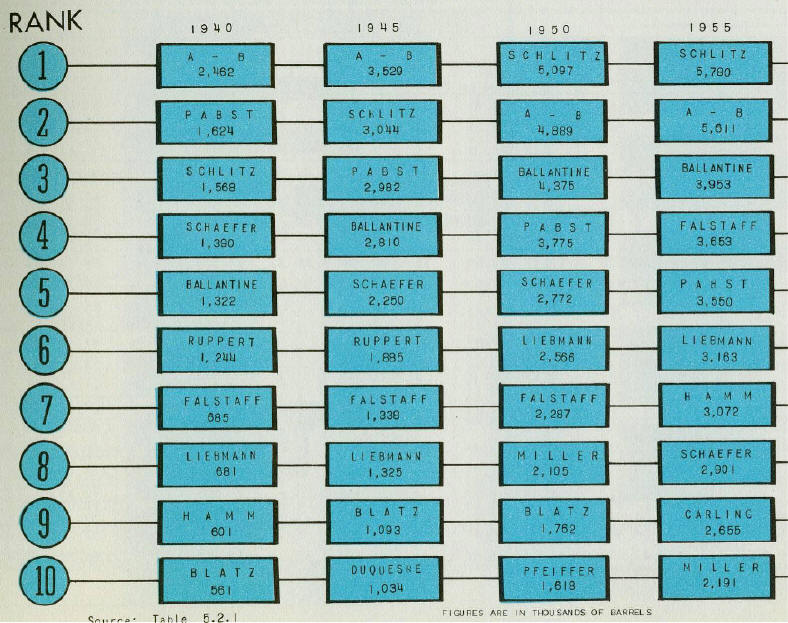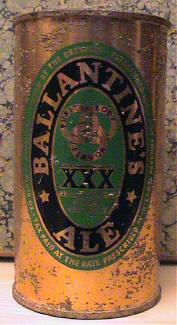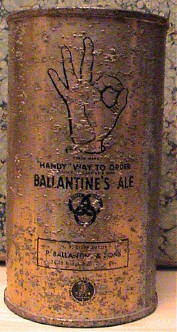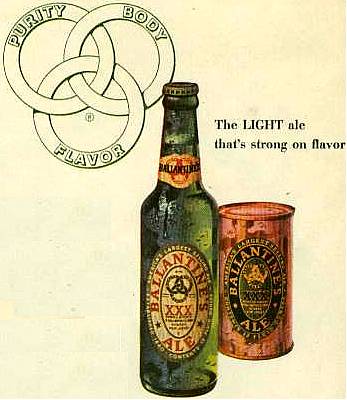Ballantine Ale "Handy Can": 1939
This can was part of a series of cans with different backs, which Ballantine used from 1938 to 1941. My Ballantine page has more photos and details about this neat series. This particular can is called the "Handy" can, and was part of a new advertising campaign. Since 1879 Ballantine had used a three ring logo, with the rings labeled purity, strength, and flavor respectively. According to legend, the logo was created when the owner saw three moisture rings left ton the bar by his beer glass in a tavern. The three-ring logo was so successful that it was instantly recognizable throughout the eastern United States where Ballantine was sold. In 1935 Ballantine used an advertising campaign explaining how the 3 ring logo originated. This campaign was followed by a series of playful ads playing on the 3 rings image. In 1938 the created the "Handy" campaign in which a circle was formed with the thumb and forefinger and the other three fingers were held upright to indicate that there were three rings. Of course, this gesture also means "OK."
This particular can is dated February 8, 1939 on the bottom. Ballantine Brewing: 1840-1971
Founding Success
Ballantine Brewing was once the 4th largest brewer in the United States. Founded in 1840 in Newark by Peter Ballantine, a native of Scotland. Originally called the Patterson & Ballantine Brewing Company, Ballantine and his partner rented an old brewing site which dated back to 1805. In about 1850 Ballantine bought out his partner and purchased land near the Passaic River to brew his popular ale. His three sons joined the business and in 1857 the company was renamed P. Ballantine and Sons, a name it kept until it closed almost 115 years later. By about 1879 it was the sixth largest brewery in the US, almost twice as large as the current giant, Anheuser-Busch. They added a second brewery location, also in Newark, in order to brew lager beer to accompany their ale. Peter Ballantine died in 1883. His eldest son had preceded him by a few months and the second son assumed control of the company until his death from cancer in 1895. The last son died in 1905 and the company was taken over by George Frelinghuysen, the company's vice-president.
The 3 Ring logo from an ad circa 1939.

The Ballantine Brewery in Newark in the late 19th Century.
Note the 3-ring logo in the lower left.
Prohibition
The company had diversified before Prohibition into insurance and property sales. When Prohibition began in 1920, Ballantine switched its brewing facilities to making malt syrup, which was still legal and popular among home brewers and bootleggers alike. Unfortunately, a lot of in-house skills were lost during the dry years, so when Prohibition was coming to a close in 1932 the company owners wavered as to whether or not to begin brewing again. A pair of German brothers named Badenhausen approached the owners with an offer to purchase the brewery and the Badenhausens took over P. Ballantine & Sons on June 1, 1933. Carl Badenhausen controlled the company until 1969.
Post-Prohibition Success
Ballantine Brewing quickly became a dominant power within the brewing industry, especially in the eastern half of the country. By 1935 they were the second largest brewer in the country. They were also a leader in canning beer, starting in 1935 (see my Ballantine page for pictures of early cans). They are also credited in being one of the first brewers to sell cans in a six pack. Ballantine remained one of the major brewers for the East through the 1940s and 1950s. Like many brewers they sponsored sports events, including NY Yankee's play by play broadcasts featuring Mel Allen. They also had a huge billboard in Philadelphia's Connie Mack stadium. They even owned the Boston Celtics for a time. In 1943 they bought out another Newark brewer, Christian Feiganspan, whose plant they used until 1948. However, national brewers including Pabst and Schlitz began to move more into Ballantine's traditional New York City base. Schlitz opened a brewery in Brooklyn, while Anheuser-Busch and Pabst opened plants in Newark. But while other brewers expanded to multiple brewing locations, Ballantine continued operating its one facility.
Chart of the Top 10 Brewers: 1940-1955. |
 |
The End Comes, Slowly.
By the 1960s Ballantine's star was fading. From 1955 to 1960 they dropped from 3d to 6th place among US brewers with their production dropping to 3.2 million barrels. In 1965, as Ballantine was celebrating its 125th anniversary, the brewery began to lose money. Badenhausen decided to sell the brewery and in 1969 it underwent only the third change in ownership since its founding in 1840. By this time Ballantine had dropped out of the top 10 brewers. The business kept losing money however, even under new owners, so in 1972 its labels and distribution network were sold to Falstaff Brewing. Ballantine beer continued to be produced but the labels moved from one brewer to another. Currently Ballantine Ale is being brewed for Pabst by Miller in Trenton Ohio and is for sale in a few eastern states.
Sources Used:
Badenhausen, Carl W. "The Story of Ballantine's Advertising Campaign" Brewer's Digest (April 1939) 46-48, 61-61. (Condensed from Printer's Ink, March 30, 1939)
Beer Can Collectors of America. United States Beer Cans (Beer Can Collectors of America: Fenton, Mo) 33.
Beer Can Collectors of America. Catalog of American Beer Cans. (1993) 390.
Glaser, Greg. "The Late, Great Ballantine" Modern Brewery Age. (27 March 2000)
Smallshaw, John. "P. Ballantine & Sons of Newark: History of a One-Time Industry Major Player" American Breweriana Journal (November December 2002) 15-21.
Van Wieren, Dale P. American Breweries II (West Point, PA.: East Coast Breweriana Association, 1995) 208-210.
Special thanks to Matt Menke!
Websites
A Nice History of Ballantine Brewing by a Falstaff Fan.
Old Newark has some info on the brewery.



